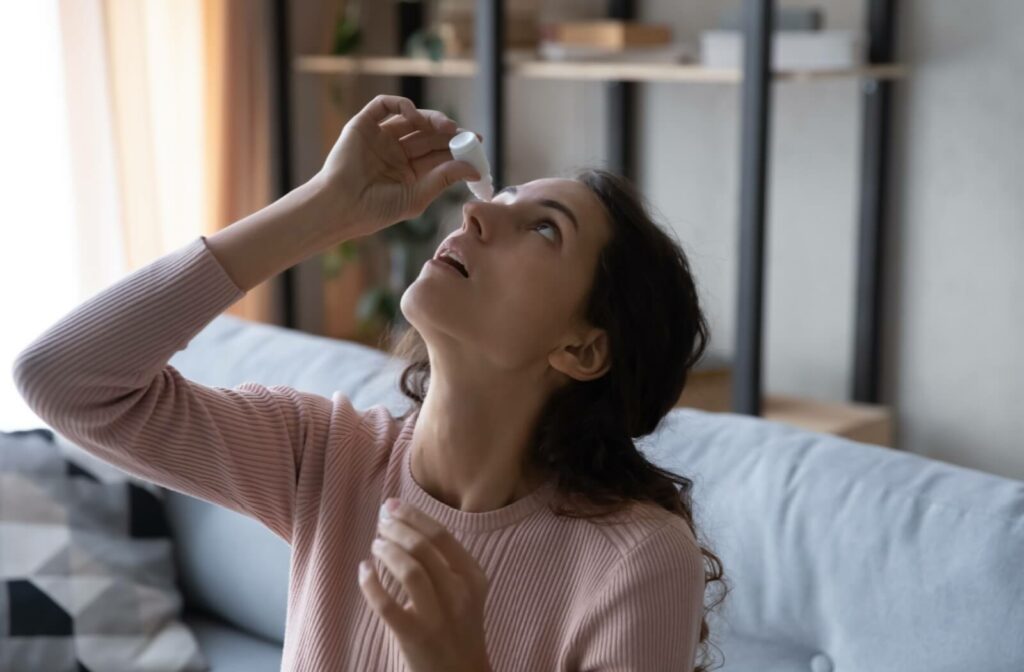Meibomian gland dysfunction (MGD) is a common eye condition that impacts the meibomian glands, which are small oil-producing glands in the inner rim of your eyelid. MGD occurs when these glands don’t produce enough oils or poor quality oils, leading to dry eye.
Though it may seem complex, MGD is manageable with proper diagnosis and treatment. Effective treatment options include IPL (intense pulsed light) and RF (radiofrequency).
What Are Meibomian Glands?
The meibomian glands are tiny glands located along the edge of the eyelids that secrete oil. When these glands function properly, they contribute significantly to the balance and quality of the tear film, protecting the eyes from dryness and irritation.
A balanced tear film consists of 3 layers:
- The water layer, which keeps the eyes moist.
- The oil layer, which prevents tears from evaporating.
- The mucous layer, which helps tears stick to the eye surface.
However, if there’s a problem with the meibomian glands, the amount of oil in your tears decreases. A decrease in oil leads to an imbalanced tear film that causes your tears to evaporate too quickly, causing dry eye.
Common Symptoms of MGD
Common symptoms of MGD can include:
- Gritty eyes or a feeling of something in the eye
- Irritation and itchy eyes
- Sore or burning sensations in the eyes
- Redness
- Blurry vision
- Light sensitivity
- Watery eyes
Causes & Risk Factors of MGD
Some people are at a higher risk of developing MGD than others. These factors can increase your risk of MGD:
- Poor Eyelid Hygiene: Inadequate cleansing of the eyelids can lead to a buildup of debris and bacteria along the eyelid margins. This accumulation can block the meibomian gland ducts, preventing the normal secretion of meibum and contributing to MGD. Regular and thorough eyelid hygiene is essential in maintaining the proper function of these glands and preventing blockages.
- Age: As you age, the efficiency and functionality of the meibomian glands naturally decrease. This age-related decline can result in less meibum production and a higher risk of developing MGD. Aging can also lead to changes in the composition of the meibum, making it thicker and more likely to clog the glands.
- Environmental Factors: Various environmental factors can exacerbate MGD symptoms. Low humidity levels can cause increased tear evaporation, creating a greater demand for meibum. Prolonged screen time often leads to reduced blink rates, which can impair the even distribution of meibum across the eye surface. Exposure to air pollutants and irritants can also contribute to inflammation and blockages in the meibomian glands.
- Systemic Conditions: Certain medical conditions can predispose individuals to MGD, like rosacea, blepharitis, and Sjogren’s Syndrome. Rosacea, a chronic inflammatory skin condition, is known to affect the meibomian glands and lead to dysfunction. Blepharitis, an inflammation of the eyelid margins, can also obstruct the meibomian glands and disrupt their function. Autoimmune diseases, such as Sjogren’s syndrome, can reduce tear production and alter the quality of meibum, further increasing the risk of MGD.
Diagnosing MGD
An in-depth dry eye consultation can not only determine if you have dry eye, but also determine if your dry eye is caused by MGD.
At your dry eye consultation, you will be given a comprehensive screening questionnaire, then a technician will take a series of images of your eyes with the OCULUS Keratograph® 5M. It creates detailed, full-colour digital images and videos of your eye. It also shows your actual tear volume, another indicator of dry eye.
With this information, your eye doctor can diagnose the cause of your dry eye, and take future images to see how your treatment is progressing.
At the end of your dry eye assessment, you’ll get a report called the Crystal Tear Report that explains each test and how your results are scored. Your doctor will review the results with you and formulate a treatment plan tailored specifically for your eyes and symptoms.

MGD Treatments
Once your eye doctor diagnoses the underlying cause of your symptoms, they can recommend a personalized treatment plan based on your needs.
Traditional dry eye treatments, like eye drops and warm compresses, often aren’t effective for many patients. Now, there are more advanced treatments like IPL and RF that help provide many MGD patients with relief.
IPL (Intense Pulsed Light) for MGD
InMode Lumecca intense pulsed light treatment (IPL) works to control the inflammatory process, stopping the continuous cycle of inflammation. It can also help reduce or eliminate the need for medication for MGD.
IPL treatment involves flashes of light to the skin around the eyelids and face. Light gets absorbed by the mitochondria of the meibomian glands. This helps to switch glands “on,” making them more active and produce more meibomian oil.
In addition to MGD, IPL can treat ocular rosacea, Demodex mites, and a variety of skin appearance issues like age spots, sun damage, pigmented lesions, freckles and more. It’s approved by Health Canada as a safe and effective treatment for dry eye, including dry eye caused by MGD.
RF (Radiofrequency) for MGD
InMode Forma-I radiofrequency treatment (RF) uses radiofrequency energy to generate heat which is applied to the skin around the eyes. This heat stimulates collagen formation, increasing the number of white blood cells and stem cells around your eye while reducing inflammation.
The main benefits of RF are:
- Safely heating the meibomian glands for expression
- Tightening existing collagen in the upper skin layers
- Stimulating the production of new collagen in the deeper skin layers
RF helps unclog meibomian glands, allowing for improved tear production and secretion. It also has aesthetic benefits, like reducing the appearance of wrinkles, crow’s feet, and droopy eyelids.
The Forma-I has been approved by Health Canada as a safe and clinically proven treatment for dry eye.
Tips for Day-to-Day Management of MGD
Lifestyle adjustments can also help manage MGD symptoms. These can include:
- Using a humidifier: A humidifier can add moisture to the air, alleviating dryness.
- Wearing protective eyewear: Wearing wrap-around sunglasses can shield your eyes from wind and dust.
- Making dietary changes: Including omega-3 fatty acids in your diet can enhance gland function.
- Scheduling eye exams: Scheduling regular eye exams with your eye doctor can help with early detection and management of MGD.
Long-Term Relief for Dry Eyes
Meibomian gland dysfunction is a significant eye condition that can affect your quality of life. Understanding its causes, symptoms, and treatments can help provide you with relief. If you suspect that you might have MGD, book an appointment with Trail Vision Care Clinic. We can help you explore tailored treatment options for MGD management and symptom relief.




